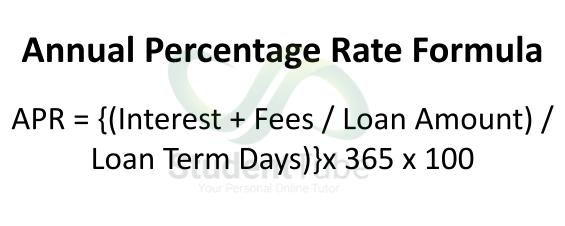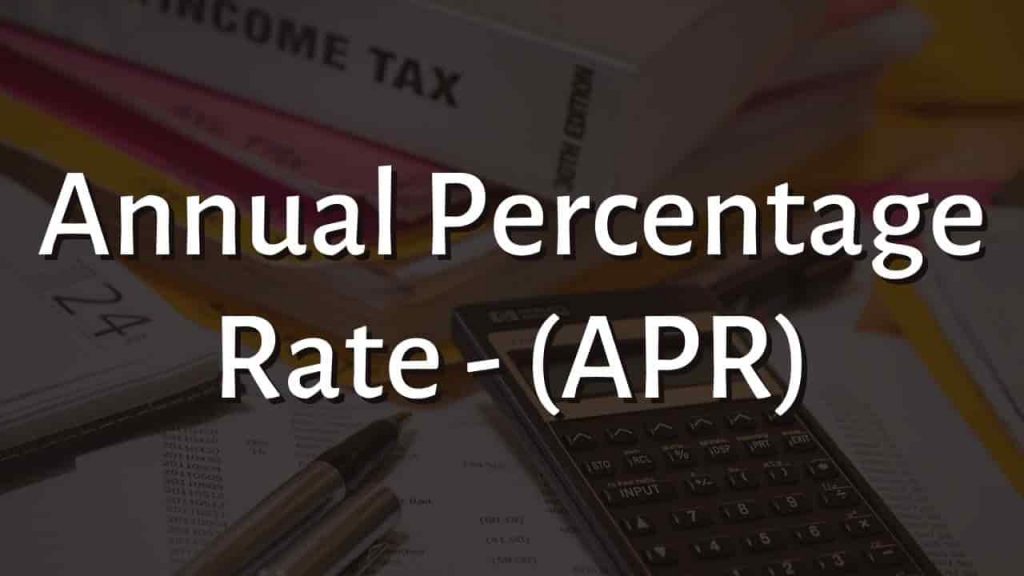Annual Percentage Rate (APR)
A loan’s annual percentage rate (APR) is the total amount of interest paid each year. This is determined before compounding interest is applied. The annual percentage rate (APR) is expressed as a percentage of the loan balance.
When you borrow money, whatever interest you pay enhances the price of the items you purchase with that money. Credit cards, as well as loans and lines of credit, are all forms of borrowing.
Knowing the APR of a credit card or loan allows you to compare options. It also displays the exact cost of what you are purchasing.
For example, if a credit card has a 10% APR, you may pay around $100 for $1,000 borrowed each year. When all other factors are equal, the loan or credit card with the lowest APR is usually the cheapest.
How Does APR Works
When you borrow money via a loan, credit card, or another line of credit, you must pay interest on the amount borrowed. The annual percentage rate (APR) is the total rate you pay for that loan or credit debt each year.
When it comes to credit cards, the APR and interest rate are frequently the same. Other loans, such as mortgages, require you to pay closing fees, which are factored into your APR. However, credit card costs such as annual fees and late payment fees have no effect on your APR.
When you carry a balance on your card, the card issuer uses the APR to determine how much interest to charge you. Many credit card companies charge interest based on your daily balance. This is how much money you owe at the end of each day.
The credit card firm divides your APR by 360 or 365 to convert it to a daily periodic rate.
The majority of credit cards have a grace period. This permits you to borrow money with no interest as long as you pay off your whole credit card debt each month. If you hold a balance on your card, you will be charged interest at the APR.
Calculation Of Annual Percentage Rate
To determine a loan’s APR, you must consider the principal amount, the number of years the loan will continue, and any other costs that the loan will suffer in addition to interest.
To calculate APR, perform these steps:
- Determine the interest rate
- Subtract the administrative expenses from the interest rate.
- Subtraction by the loan amount (principal)
- Divide the total number of days in the loan term by the total number of days in the loan period.
- Multiply everything by 365. (one year)
- To convert to a percentage, multiply by 100.
The annual percentage rate formula is as follows:

APR = {(Interest + Fees / Loan Amount) / Loan Term Days)}x 365 x 100
Annual Percentage Rate Vs Interest Rate
The annual cost of a loan to a borrower is stated as an interest rate, which is expressed as a percentage. The annual percentage rate (APR) is the yearly cost of a loan to a borrower, including fees. The APR, like the interest rate, is represented as a percentage.
The key distinction between interest rate and APR is that APR offers a more comprehensive picture of what you’ll pay when borrowing money. Because APR includes your interest rate as well as any expenses associated with your loan, your APR will be larger than your interest rate. You might also consider APR to be your effective rate of interest.
Difference Between APR And Nominal Interest Rate
There are a few important distinctions between APR and nominal interest rate, which are as follows:
The annual percentage rate estimates the entire cost of borrowing every year, whereas the nominal interest rate is the interest on a borrowed sum.
The annual percentage rate is calculated using the actual interest rate that has been adjusted for inflation, as well as any ancillary administrative charges of borrowing every year. The nominal interest rate does not take inflation into account.
The annual percentage rate is used to evaluate loans realistically for a borrower, although the nominal interest rate is not always appropriate.
Disadvantages of Annual Percentage Rate
While APR is a useful tool for estimating the overall cost of borrowing, it has limitations that make it unsuitable for comparing loans. The following are the major drawbacks of using APR alone as a comparison index when selecting a loan package:
- APR only works if you are certain that you will repay the loan in full. If you want to refinance the loan in the middle, the terms and circumstances for obtaining a new APR from a different lender may change, rendering your initial APR calculations obsolete.
- The annual percentage rate (APR) varies per lender. When looking for a loan, it is critical to compare all of the rates available, especially those with ancillary expenses and variable interest rates. If the interest rate is variable, the APR may be inaccurate since every change in the interest rate affects the entire cost of the loan.
- The compounding impact of interest rates is not taken into account by APR. The APR will not be a fair predictor of cost when there is a compounding impact of interest rate in a loan decision.
For more click here and if you are looking for full forms of different acronyms and words then check out this list you really gonna find this helpful. We also have an Essay on every topic, Check the complete list here. If you are Studying in Matric Free Video Lectures of Maths, Physics and English are here, and we have got you covered for I.COM Business Maths also.







